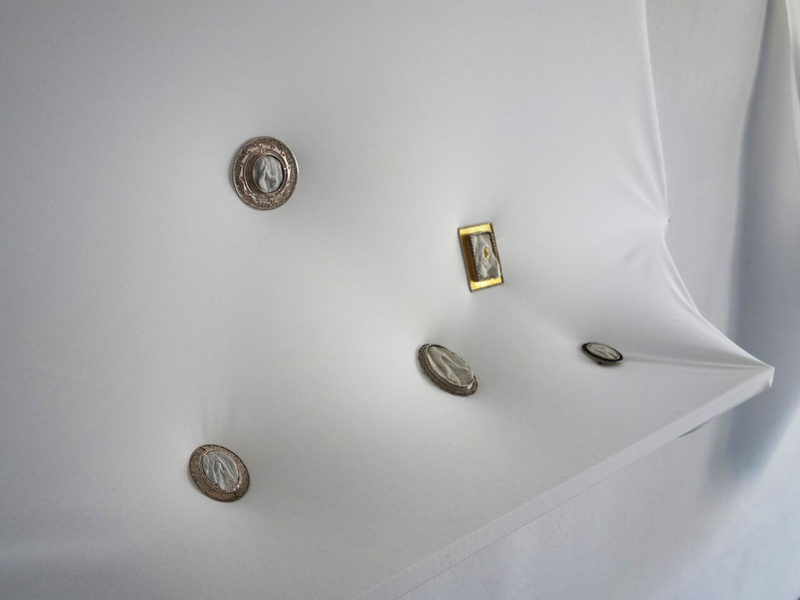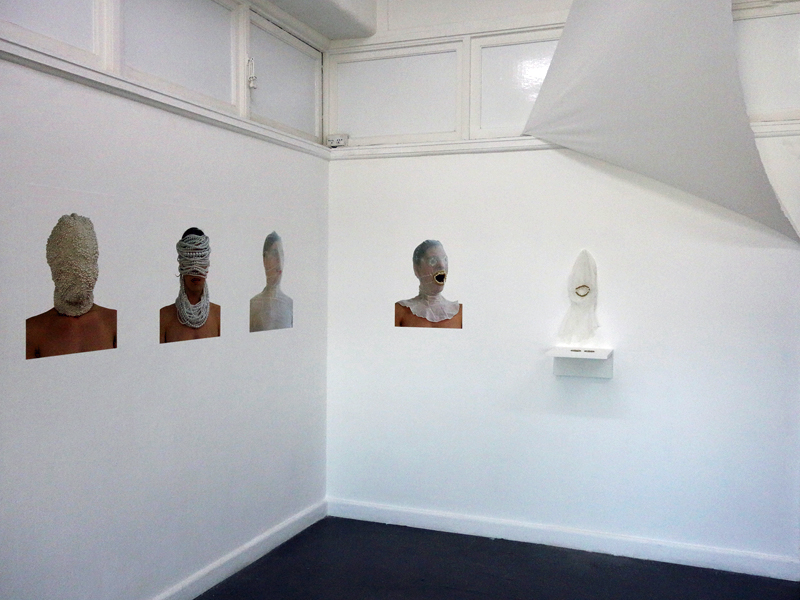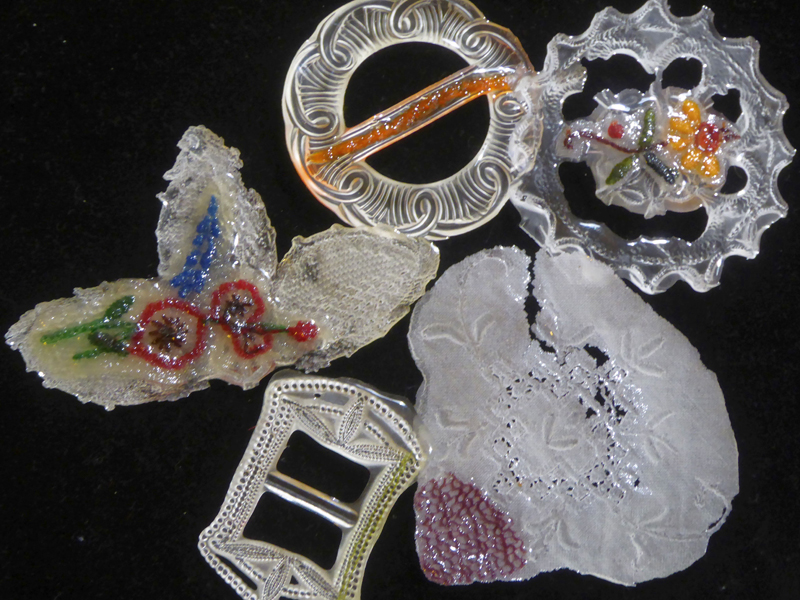The theme, direction and format was entirely up to the writers, but the pieces reflect on the event in some way—what they saw, issues that arose, discussions that were sparked etc. This essay by Kylie King, an art historian, is the last of four, and describes some works by four artists from around the globe, shown in various exhibitions during the 2017 biennial, that subvert (gender) hierarchies and interrogate (body) politics.
Honneur à l’objet![1]
Jewelry and objects[2] have the power to transgress their material embodiments. For the surrealists, objects were not passive, but could possess latent energies and revolutionary potential, which could be released by altering their form or context. In 1936, the group mounted the Surrealist Exhibition of Objects at the Galerie Charles Ratton in Paris, in which they presented their revolutionary sculptures—ordinary objects that had been found, transfigured, and transformed—designed to question perceptions, challenge accepted hierarchies and classification systems, and reject the conservative social and political conditions of pre-WWII society.[3]
Similarly, many of the artworks and exhibitions presented as part of Radiant Pavilion, in Melbourne, Australia, from August 26–September 3, 2017, demonstrated that contemporary jewelry and objects can also draw upon the agency of things to challenge perception, interrogate political and social mores, and incite pride or protest. Indeed, the works discussed below—shown in various exhibitions during the biennial—demonstrated a collective concern for the meaning of things, and their ability to impact and shape our social and cultural experiences.
***
In Tacit Recollection (curated by Yufang Chi and shown at Blindside Gallery), Nymphs—a series of full-frontal and anatomically correct cameo-like sculptures of female genitalia made by French jeweler Carole Deltenre and delicately framed as brooches in silver and gilt filigree—not only unabashedly presented the female sex as strongly present, but also flouted the prevalence of the traditional concept of the (female) body as an “object of desire” and subject of the male gaze. Indeed, the brooches embody a certain dialectical tension. Historical power relationships are represented by the invitation to touch—that is, the fundamental functionality of the objects, coupled with the representation of “visceral elements of intimate bodily form” in the cameos.[4] Their contained, diminutive sizes, moreover, reference the notion of the female body as something to be possessed and hidden. Yet the brooches are easily consumable, wearable items—if worn on a lapel, they frame the feminine as an identity to be worn with pride. By subverting traditional manifestations of brooches, Deltrenre’s jewelry is charged with the power to undermine traditional gender hierarchies and social codes.

Also shown at Tacit Recollection, But if the Crime Is Beautiful… Hood (5) (2), (6), (10), by American artist Lauren Kalman, protests the eroticization and fetishization endured by women and their bodies. Kalman’s photographs of a woman wearing diverse sensuous “hoods,” coupled with the physical presence of Hood (5)—a semidiaphanous head covering embellished and reinforced with pearls and beads—references and interrogates notions of adornment and the female body in visual culture. In each photographic image, the wearer’s sense of sight, sound, taste, and perhaps touch is controlled, restricted, or muted by what she was wearing—pearls, textiles, and glass beads. There is a certain latent violence: Appended expectantly from the wall, Hood (5) appears as an instrument of torture awaiting its next victim. (This is also reinforced by the accompanying image of it in use.)
Reminiscent of British surrealist Eileen Agar’s Angel of Anarchy (1936–1940),[5] in which a woman is blindfolded with silk and adorned with feathers and beads, Kalman’s elegant hood muffles the protests of its wearer, whose sight is blinded by the beautifully beaded blinkers placed upon her eyes, her mouth held agape and her scream silenced by the opening made rigid by a pearl and glass bead lining. Like Agar’s angel, Kalman’s hoods are bound in ambiguity. Juxtaposing beauty and violence (notions also echoed in the titles of the works), they contravene the gagging fetishization and objectification of the female body by cultural systems of control.

At the turn of the 20th century, members of the Women’s Social and Political Union in England and suffragists in Australia and America donned violet, white, and green pendants, brooches, and lapel badges—their political unity strengthened by these wearable objects, which allowed them to proclaim allegiance to each other and their cause through symbolism.[6] New Zealand artist Justine Fletcher’s installation, 2348—Melbourne Tailoresses’ Union Triptych, displayed at the Victorian Trades Hall Council Building, drew upon the historical legacy of female activism to further explore the potential of jewelry to challenge gendered hierarchies.
Fletcher’s work takes as its subject a series of strikes enacted by female tailors in Melbourne who, between 1882 and 1883, petitioned for improved working conditions and the recognition of the female labor force. Fletcher cast 2,348 resin pendants from pieces of fabric donated by members of the Trades Hall Council and the Textile, Clothing and Footwear Union of Australia. Each piece represented the name of one of the 2,348 attendees recorded in the Melbourne Tailoresses’ Strike Book.[7] Colored threads trapped in some of the resin further strengthened the visual connection between the old fabric and the new pendants. Although the pendants are not wearable, they embody the symbolic power of jewelry to convey a message. (This is also underlined by Fletcher’s choice of display location.) Indeed, by invoking the unifying and communicative symbolism of objects, Fletcher’s installation not only paid homage to the women who bravely fought for their working rights, but, through jewelry, also connects historical events with the present.[8] Her objects thus also highlight the ongoing struggle of working women today.

Belgian artist Anneleen Swillen, whose work was presented in Without A Jewel, curated by Victoria Cleland and Judith Torzillo, chose not to present physical objects (she is a trained jeweler), but rather collections of images that conceptually interrogate the ways in which we perceive, experience, and interpret objects as—or not as—jewelry. Mounted on the walls of a foyer in the Melbourne City Library, two digital monitors each played a screen-capture video of the feeds of her Instagram accounts, waysofpresentation and anneleenswillen (con)temporary jewellery—image archives or photographic series that both function as research and artistic platforms. For (con)temporary jewellery, Swillen posts a daily picture of something that could be considered jewelry due to its connection with the body (a bruise, a hair, a bandage) or because it possesses a certain materiality or form reminiscent of classical conceptions of jewelry (the loop of a tin can lid pulled over a finger, a wire coiled over a hand).[9]
Modelled “in use” and on the body, Swillen’s “(con)temporary jewels” exploit the expected condition of jewelry as precious and, by using mundane materials, subvert expectations of that which would be traditionally considered jewelry. This point is also underlined by her choice to present them digitally—are these works objects at all?
The stripped-back mode of presentation further emphasizes the fundamental concerns of Swillen’s objects. And by situating the (con)temporary jewellery monitor in close proximity to waysofpresentation—even though they also stood alone as individual works[10]—Swillen, Cleland, and Torzillo poetically demonstrated the relationship between function and perception—it was evident that they inform each other.

What all of these differing works demonstrate is the potential of objects to transcend and subvert our learned associations and expectations—to be revolutionary. Those pieces traditionally considered mundane or non-jewelry are able, when considered in terms of wearability or in the context of “jewelry-ness,” to force us to reconsider expected associations and values. Others, too, can draw upon the historical and political symbolism bound in more traditional jewelry forms to subvert (gender) hierarchies and further interrogate (body) politics.
[1] Salvador Dalí, “Honneur à l’Objet!,” Cahiers d’Art 15, 1936, 24–25.
Cahiers d’Art magazine published a special issue on the topic of the Surrealist object on the occasion of the 1936 Surrealist Exhibition of Objects. In his contribution, Dalí alludes to the political and symbolic power of objects—with particular reference to contemporary politics.
[2] The terms “jewelry” and “objects,” and “jeweler” and “artist,” are considered interchangeable and indistinguishable by this author.
[3] This was one of a number of exhibitions staged by the Surrealists throughout the 1930s and 40s that presented the object as a vehicle for the expression of the Surrealist ideology. For recent texts that examine the Surrealist object, exhibitions, and politics, see Janine Mileaf, Please Touch: Surrealist and Dada Objects after the Readymade, Hanover, NH: Dartmouth College Press, 2010, and Johanna Malt, Obscure Objects of Desire: Surrealism, Fetishism and Desire, New York: Oxford University Press, 2004.
[4] Elizabeth E. Grierson, Bodies and Jewellery in Tacit Recollection, catalog essay: http://www.blindside.org.au/tacit-recollection/ (accessed September 4, 2017).
[5] http://www.tate.org.uk/art/artworks/agar-angel-of-anarchy-t03809 (accessed September 3, 2017).
[6] https://www.moadoph.gov.au/blog/votes-for-women-a-recently-acquired-example-of-suffragette-jewellery/ (accessed September 8, 2017).
[7] The unifying nature of these symbols is further illustrated by the fact that a number of women from other unions also contacted Fletcher via the project’s Facebook page because they, too, wanted to contribute. Email correspondence with the artist, September 9, 2017.
[8] In an act of poetic symmetry, Fletcher recorded the names and addresses of the fabric donors. Email correspondence with the artist, September 9, 2017.
[9] Renée Ugazio and Anneleen Swillen, “Observing, Presenting and Curating Jewellery: “Jewelleryness” as an Approach and a Characteristic,” Without A Jewel, Victoria Cleland and Judith Torzillo (eds), exhibition catalog, Melbourne, 2017, 33, 37.
[10] Thank you to Judith Torzillo, who pointed this out to me in our email correspondence, September 12, 2017.




